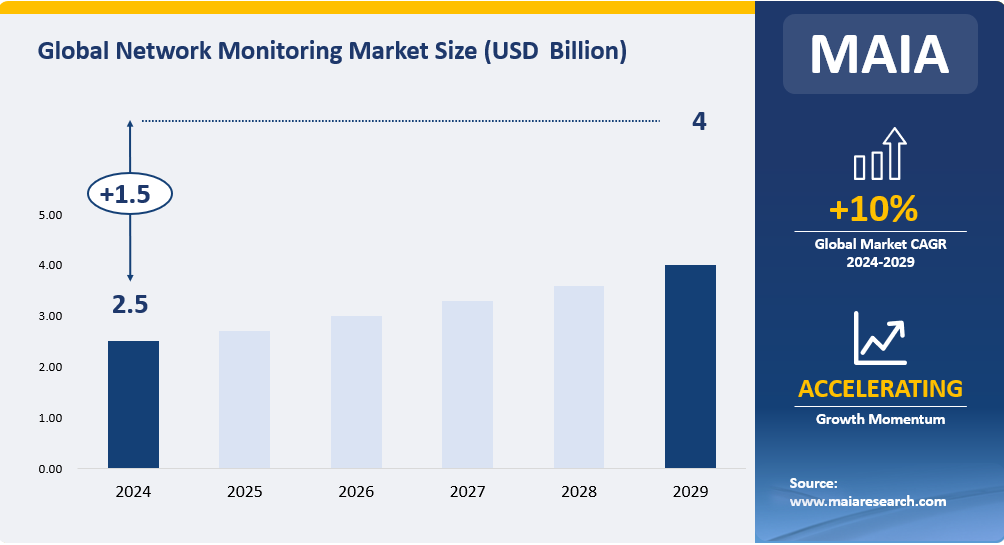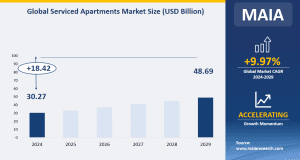The global network monitoring market is projected to reach USD 2.5 billion in 2024, with a CAGR of 10% during 2024-2029.

Definition
Network monitoring, a subset of network management, is a systematic attempt by a computer network to identify slow or failing components before they cause problems. For example, crashed, frozen, or overloaded servers; failed switches; failing routers; and other troublesome components can all potentially cause outages or network failures. Should some problem arise and trigger an outage, it is the role of the network monitoring system to alert the network administrator in a timely way. Network monitoring tools and systems constantly monitor a network’s health and reliability by tracking and logging network parameters and searching for trends.
Top Companies
In 2023, Datadog was the company with the largest market share in the industry, accounting for 18.58% of the revenue market share. Datadog is an essential monitoring and security platform for cloud applications. Datadog brings together end-to-end traces, metrics, and logs to make applications, infrastructure, and third-party services fully observable. These capabilities help businesses protect their systems, avoid downtime, and ensure customers have the best user experience. Datadog Network Performance Monitoring provides full visibility into every network component that makes up on-prem, cloud, and hybrid environments, with little to no overhead. By monitoring the performance of connections among hosts, services, virtual private clouds (VPCs), and other elements, user can quickly determine when network is the root cause of any issue.
Key players in the network monitoring market include Datadog, Splunk, Dynatrace, SolarWinds, LogicMonitor, Auvik, Progress, Paessler, ZOHO Corporation, Netsurion, NinjaOne, Soneco, etc. The top 3 companies accounted for approximately 41.76% of the revenue share in 2023.
|
Global Network Monitoring Revenue Share of Top 3 Players in 2023 | |
|
Datadog |
18.58% |
|
Splunk |
14.41% |
|
Dynatrace |
8.77% |
Market by Type
Based on type, network monitoring is divided into cloud-based and on-premise.
On-Premises type products mainly refer to network monitoring that is usually done locally and only employees within the organization can securely access. By having network monitoring locally, users have a higher level of control than cloud-based solutions. Typically, an enterprise’s in-house IT professionals may prefer to keep network monitoring software on-premises so they can personally configure the solution to fully meet their needs and monitor in real time.
Cloud-Based type products usually refer to network monitoring running on cloud infrastructure. Cloud-based network monitoring has enormous flexibility and scalability without significant capital expenditures. Cloud-based network monitoring checks performance anytime, anywhere on any connected device. If the latest software upgrade or version comes out, the user’s Managed Service Provider (MSP) will handle the upcoming migration and will also provide all hardware resources to support network monitoring.
The following table shows the revenue market share of different types of network monitoring.
|
Type |
Revenue Share in 2023 |
|
On-Premises |
78.35% |
|
Cloud-Based |
21.65% |
Market by Application
The network monitoring market is divided into governments, corporations, and individuals according to the different customer fields.
The following table shows the revenue market share of different applications of network monitoring.
|
Application |
Revenue Share in 2023 |
|
Governments |
23.88% |
|
Corporations |
60.89% |
|
Individuals |
15.23% |
Network Monitoring Market Drivers Analysis
‘North American demand for network monitoring is steady and rising’
From a global perspective, North America has the largest market. This is primarily due to increased IT capacity needs and the continued adoption of new data center technologies. In the US, the US IT infrastructure is constantly improving. As many organizations adopt advanced technologies, IT infrastructures are becoming more complex, larger and more distributed. IT departments are upgrading existing systems to accommodate hardware changes, support machine virtualization, and run applications in different data centers. Monitoring solutions help IT drive decisions about resource allocation, troubleshooting, and capacity planning. Meanwhile, the United States has hyperscale data center capacity. And, some large enterprises may opt for cloud services to save upfront costs of building new data centers for business continuity. These factors are driving demand for cyber surveillance in the United States.
In Canada, there is a growing demand for network performance monitoring and infrastructure management. Some organizations are deploying network monitoring solutions to manage the flow of data across the network. The network monitoring switch manages the destination and source addresses of packets and transmits them to designated components. This helps manage network bandwidth and ensure the efficiency of the network infrastructure. It also supports in-depth monitoring by enabling access to network protocols.
As such, in North America, the region is expected to maintain its dominance throughout the forecast period with the growing adoption of hybrid cloud and advanced IT infrastructure.
Network Monitoring Market Challenges Analysis
‘High initial investment in Network Monitoring industry’
In recent years, the need for continuous monitoring has increased due to increased network complexity and security concerns. However, the high initial investment also brings challenges to the Network Monitoring industry.
For Network Monitoring enterprises, the successful development of a Network Monitoring project requires front-end system, business system and big data system and other aspects. When calculating the cost, it is necessary to estimate the manpower, resources, management and other costs required for each link from software planning, requirements analysis, design, coding, unit testing, integration testing to certification testing.
As far as the labor cost of the entire project is concerned, in general, the IT team is mainly responsible for demand analysis, system architecture design, network monitoring software development, system testing, and operation and maintenance support systems. For a long time, in order to ensure the efficiency of project development, Network Monitoring companies will spend a lot of financial resources to recruit more programmers.
Since the Network Monitoring project relies more on R&D personnel, this also makes the network monitoring companies invest higher funds in the initial stage of the project. At the same time, network monitoring projects generally face problems such as long project development cycle time. This brings challenges to the financial strength of enterprises to a certain extent.




